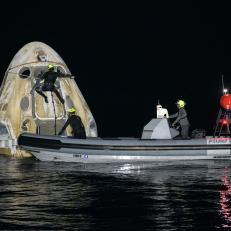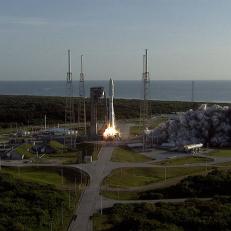NASA is Shooting a Rocket at an Asteroid and We Don’t Want to Miss It
DART, or Double Asteroid Redirection Test, is a mission to test NASA's asteroid deflection technology should the need ever arise. In the first-ever space mission of its kind, the spacecraft will launch on the SpaceX Falcon 9 Rocket out of Vandenberg Space Force Base in California.
Go behind the scenes of the making of DART with our favorite photos.
ROSA (Roll-Out Solar Array) Test
Members of APL's DART team perform a pop-and-catch test with one of DART's roll-out solar arrays (ROSA) in June 2021. The process involves first firing the frangibolt mechanisms that are holding the array so it begins to unfurl and then stopping the array before it fully unwinds. The process ensures the ROSA will properly deploy after DART launches.
DART Vibration Tests
Test engineers and the lead structural analyst on APL's DART team closely monitor real-time data of the various accelerations the spacecraft experiences during vibration tests in July 2021.
DART Seperation Shock Test
The APL DART team performs fit and shock tests on the DART spacecraft in July 2021. These tests ensure the spacecraft will properly fit onto the separation system that will connect DART to the launch vehicle and that it will safely kick away from the launch vehicle after launch.
DRACO Integration to Spacecraft
DART team members at APL install and inspect DART's only instrument - the Didymos Reconnaissance and Asteroid Camera for Optical navigation (DRACO) - onto the spacecraft in June 2021. This high-resolution imager, derived from the LORRI camera on NASA's New Horizons spacecraft, will measure the size and shape of Dimorphos, its target asteroid, and will feed the spacecraft's guidance system to autonomously direct the spacecraft to collision.
DRACO Integration to Spacecraft
DART team members at APL install and inspect DART's only instrument - the Didymos Reconnaissance and Asteroid Camera for Optical navigation (DRACO) - onto the spacecraft in June 2021. This high-resolution imager, derived from the LORRI camera on NASA's New Horizons spacecraft, will measure the size and shape of Dimorphos, its target asteroid, and will feed the spacecraft's guidance system to autonomously direct the spacecraft to collision.
NEXT-C Ion Engine Testing
NEXT-C ion engine firing during thermal-vacuum (TVAC) testing at NASA Glenn Research Center in December 2019.
DART Panel Closeout
As the integration and testing phase continues on the DART mission, the APL team carefully closes two of the DART spacecraft’s panels.
APL Receives DART Spacecraft Structure 2
The DART team has spent the last month installing the electrical harness and subsystems onto the spacecraft panels, as well as testing the spacecraft's avionics and the software for its Small-body Maneuvering Autonomous Real Time Navigation (SMART Nav) system. The DART structure will eventually be outfitted with these subsystems and SMART Nav in the coming months. Pictured from left are Shelly Conkey, Lisa Wu, Betsy Congdon and Steve Wenrich.
DART Control Room Testing
In the Ground System Equipment control room at APL, engineers perform tests and simulations on the DART spacecraft, which sits behind glass in the clean room.
DART Unboxing
DART's primary structure arrived from Alliance Space Systems in California. The APL mechanical engineering team prepared to carefully unbox what is essentially the body of the spacecraft, an aluminum honeycomb structure measuring about 6.5 feet on each side.




















